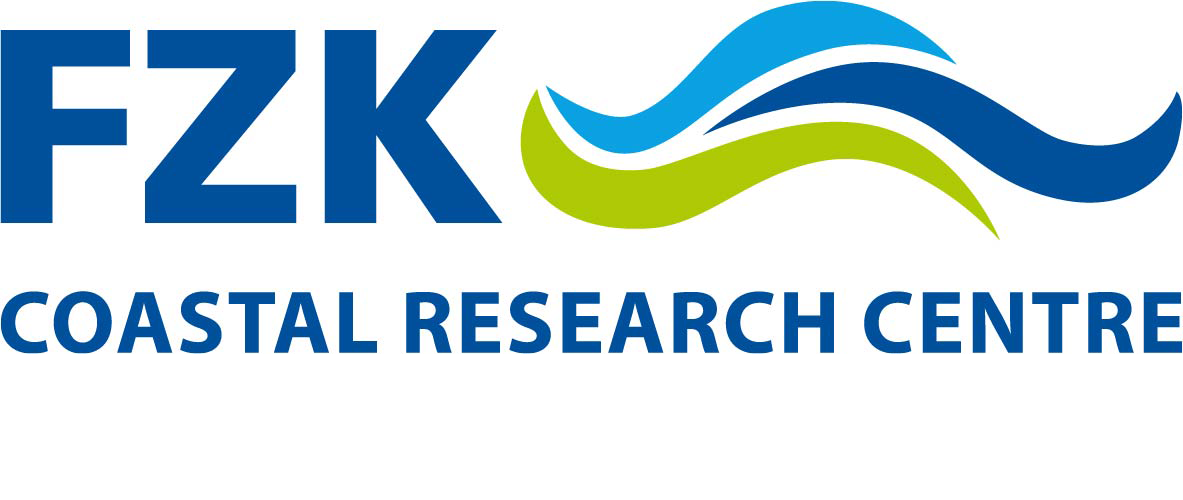Dynamic Coastal Protection: Resilience of dynamic Revetments under Sea Level Rise
 © Forschungszentrum Küste
© Forschungszentrum Küste
| Led by: | Dr. Christopher Blenkinsopp |
| E-Mail: | c.blenkinsopp@bath.ac.uk |
| Year: | 2017 |
| Funding: | HYDRALAB+ - Transnational Access |
| Duration: | 17.07.2017 - 29.09.2017 |
Scientific Background
The immediate effect of sea-level rise (SLR) is to cause coastal retreat or increased risk of coastal flooding, while other impacts include saltwater intrusion into surface and groundwater and loss of wetlands. Management of the coastline to adapt to these changing conditions is essential but represents a significant challenge to coastal managers, particularly in developed areas where loss of infrastructure would lead to significant social and economic loss.
The typical coastal management approach in sensitive or developed areas is to hold the line and coastal managers have two fundamental options to achieve this:
Hard structures (e.g. rock seawalls) which aim to reduce erosive wave energy, compartmentalise beach sediment or provide a barrier at the back of the beach to protect the land from inundation. As sea-levels rise most such structures will need to be upgraded in order to maintain their level of protection.
“Soft engineering” (e.g. beach nourishment) which aims to maintain the health of the sand buffer by artificially increasing the volume of the beach and/or dunes. This is a commonly used approach to maintain the sand buffer, particularly in areas of high recreational value where there is a desire to retain the natural character of the beach. Realistically, in many areas, the additional volumes of sand required to stabilise the shoreline as sea-levels rise is likely to become unsustainable.
While hard engineering protection may well be required in highly developed areas where the economic and social implications of failure are disastrous, in some areas a lower level of protection may be acceptable. A relatively recent shore protection method is the use of what have been variously termed “dynamic revetments”, “cobble berms” or “rubble beaches”. This approach involves the construction of a gravel or shingle ridge around the wave runup limit to mimic composite beaches which consist of a lower foreshore of sand and a backshore ridge constructed of gravel or cobbles which stabilises the upper beach and provides overtopping protection to the hinterland. These structures contrast with static coastal defence structures as they are “dynamic” and are expected to reshape under wave attack.
Objectives of the experiments
The overall aim of this project construct a prototype-scale beach and investigate the response of the beach to a rising sea level and storms with and without a dynamic revetment structure (a gravel or shingle ridge around the wave runup limit) through 3 main work packages:
WP1 - Performance of Dynamic Revetments
Determine the performance of dynamic revetments to a rising sea-level and their resilience in response to a range of high and low-energy wave conditions. Analyse the response of the sandy foreshore to SLR with and without the presence of a revetment.
WP2 – Fundamental Hydrodynamic and Sediment Transport Processes
Gain fundamental information about wave transformation in the surf and swash zones, beachface morphology change and the dynamics of nearshore bars due to changing waves and water levels. This fundamental knowledge will enable an understanding of the revetment performance and beach response to SLR, potentially indicating approaches to improve revetment design and beach resilience.
WP3 – Numerical modelling
Test and improve the capabilities of parametric and process-based models in predicting wave transformation and morphology changes of the sandy beach alone and in presence of the dynamic revetment using the laboratory results. Generalize the results to prototype conditions to optimise the dynamic coastal protection design in the presence of SLR.
Model setup and measurements
The response of two beach configurations is investigated under erosive wave conditions (Hs=0.6m, Tp=6.0s) and a total SLR = 0.4 m:
i) an unmodified sand beach with an initially plane slope of 1:15, and
ii) a natural beach profile with a dynamic revetment installed at the location of the natural berm before imposing SLR.
SLR is imposed in 4 steps of 0.1 m with and initial water depth of 4.5 m above the flume base. Each phase ran for a total of 58 hours, after which resilience testing under storm waves and accretive conditions is undertaken for a further 12 hours in each case.
The changing profile of the sand beach and revetment is monitored throughout the experiments using a traditional profiler, LiDAR array and a multibeam sonar. Additional hydrodynamic and morphological measurements like water surface elevation, water velocities and suspension rates are obtained at the location of the offshore sandbar to investigate the process of bar formation and migration with SLR.
